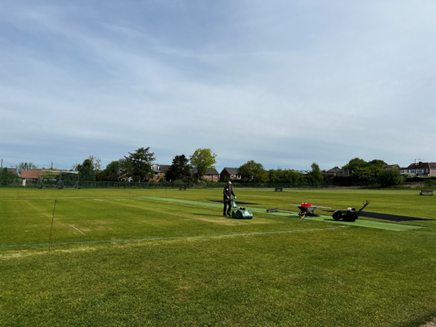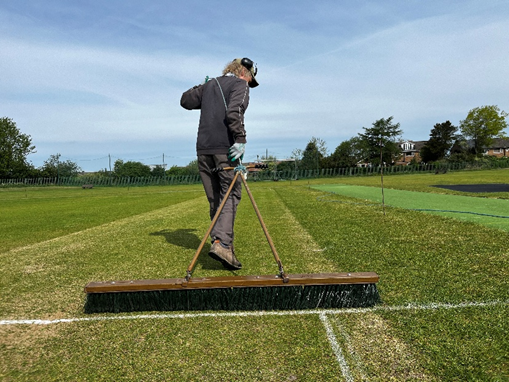Long before the first ball of a cricket match, groundskeepers already have an impact on the outcome. Every inch of grass and millilitre of moisture in a wicket matters, but their craft is being tested like never before by climate change.
A bowler stands at the top of his mark. Ten fielders are ready as he rhythmically runs in and lands the ball on a good length. The batter picks it up early and follows through with a solid forward defensive shot. The first ball of the match has been negotiated and a ripple of applause scatters out from those beyond the boundary.
Whether on the first morning of a test match or the afternoon of a third XI club game, the process of getting the pitch ready for that first ball remains the same. Months earlier, the strips were cut, measured, rolled, watered and curated into life by groundskeepers, the backbone of the game. However, climate change is creating a raft of new challenges for them.
At Hallam Cricket Club, one of the oldest clubs in England and home to the oldest cricket ground in Yorkshire, the unenvied role of head groundskeeper belongs to Mark Beckles Willson, former club chairman and player, whose time with the club spans over 30 years.
‘‘I was an architect for many years, ran a company fairly successfully and my retirement project was being a groundsman,’’ he says. ‘‘I already had the qualifications, my son played here, I played here, I’ve coached here so I’ve got a longstanding relationship with the club, and I wanted to work outdoors.’’




Beckles Willson has witnessed firsthand the growth of the club during his time at the helm of the grounds, so much so that now a pitch is being used every night of the week in the summer. They now have over 20 junior teams and say they run more youth cricket sessions than any other club in the country. Preparing the pitch for that heavy traffic is a constant battle with the elements.
‘‘Groundsmen are never happy with the weather, it’s never quite right. This year it’s been too dry, last year was incredibly wet as we lost all of April, and only just got going in May when it was still quite wet.’’
Beckles Willson’s weather complaints do have backing. The spring of 2024 saw over a third more rainfall than average and a cooler subsequent summer. Just two years earlier, 2022 was the hottest summer on record according to the Met Office. The British summer is no longer the relatively known entity it once was.
This year, we head into the body of the cricket season off the back of a late April heatwave and one of the driest preambles to summer in recent memory. The unpredictability that climate change has brought is doing groundskeepers no favours.
‘‘It makes my job a lot more difficult,’’ says Beckles Willson. ‘‘A typical British summer where you would know how the pitches are going to play through the months doesn’t exist anymore because of climate change. Anyone who tells you climate change isn’t happening needs to get a job working outdoors.’’
The weather may eventually force teams to change the way they play at home, as groundskeepers have less control over the pitches produced. During a particularly wet summer like 2024, home teams may find themselves playing on stickier, slower and lower-bouncing wickets without much say in the matter.
Hard, bouncy wickets with pace in them are almost impossible to produce at club level when the conditions don’t play ball. The weather is starting to influence and, worryingly, limit what type of pitches can be prepared in club cricket like never before.
“They will play differently depending on the weather. The way they’re playing right now is flatter because it has been drier earlier in the year. It’s completely different to the way they were playing in May last year when there was more moisture in the wicket after a lot of rain,” Beckles Willson says.
Even if changing weather takes more out of the hands of groundskeepers, the work that comes with maintaining a ground and putting on a game of cricket remains a rigorous and complex skill.
“Getting the moisture content right in a wicket is part of a groundsman’s skill, so you can roll it, and it has an effect, rather than crumble the wicket if it’s too dry,” Beckles Willson explains. “Finding a balance, making sure there’s something in it for the bowlers, and not too dry or flat, that’s the aim.”
“It’s been a challenge this year because the grass hasn’t been growing properly through a lack of rain, which creates problems. The pitches aren’t going to last very long because they’re so dry. The weather is definitely changing – and it’s going to get worse.”
While wickets drying up quicker will bring spinners into the game earlier in the English season, they can also reduce the quality and competitiveness of cricket on show. A lack of balance in the wicket can also mean that clubs don’t produce well-rounded cricketers and the pitches themselves will be in poor health, all as a result of climate change.
The majority of club grounds don’t have the tools to properly keep a pitch watered during extreme dry conditions. As clubs form the pathway to county and professional cricket, this could massively damage the game as a whole in the UK.
In 2023 the England and Wales Cricket Board signed up to the UN Sports for Climate Action Framework, becoming the first national cricketing body to do so. They also implemented sustainability practices such as cutting out single-use plastics, and committing to more efficient travel.
However, without the funding, irrigation systems, big grounds teams and full pitch covers of professional cricket or sufficient help from the ECB itself – who are technically the governing body for all club cricket in England and Wales – the grassroots side of the game will be left to fend for themselves against a climate changing faster than many can cope with.
“It’s become very difficult to forecast the weather,” Beckles Willson says. “I look, as you can imagine, at the forecast about ten times a day, and it might say there’s less than a 5% chance of rain all day. Then you look out the window in the afternoon — and it’s pouring.”
“The weather is more varied and more extreme than ever. It makes my job more difficult because there isn’t a pattern you can follow anymore, so now, you’ve got to do different things every year.”
While bigger, historic clubs like Hallam CC hope to be able to hold their own in an ever-worsening situation for club cricket in England, smaller clubs in Yorkshire and throughout the country may not be so lucky in the coming years. If more isn’t done to protect all those at the base of the system, the foundation and pathways of cricket in this country will fall to the dramatically changing weather.
Sidelines Recommends

Miles of planning: who makes the London Marathon happen?
On your marks, get set, GO! You see the runners cross the finish line, but what goes into setting up the London Marathon? Sidelines speak to the route manager to learn more. Sophie Blackett has been the route manager of the London Marathon for three years, as well as…

From root to pitch – how are cricket bats made?
Making a cricket bat is no easy task. This is how Wombat Cricket crafts the perfect bats… Harry Solomon, photo courtesy of Harry SolomonWe often buy cricket bats without a second thought, but at Wombat Cricket, there’s a whole lot more consideration to it. From…

“I was given four to six months to live”: athletics coach John Powell’s story
Whether it’s shaping future Olympians or them helping save his life, athletics coach John Powell MBE proves coaching doesn’t stop at the finish line.




